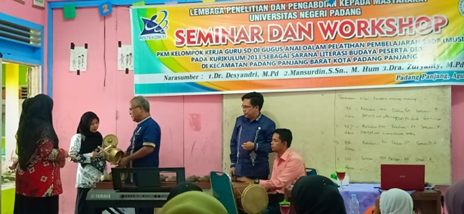Pelatihan Pembelajaran Seni Musik sebagai Sarana Literasi Budaya untuk Guru Sekolah Dasar Music Arts Learning Training as a Means of Culture Literation for Elementary School Teachers
Main Article Content
Abstract
The background of this service is the lack of knowledge and skills of teachers in making music as a cultural literacy for elementary school teachers. The purpose of this service is to improve the experience and skills of primary school teachers in learning the art of music as a means of cultural literacy for elementary school teachers. This service method uses the seminar method and hands-on training. The results of the dedication showed an increase in the knowledge and skills of teachers in making music art learning a cultural literacy for elementary school teachers. The implications of this service can be used as a reference by teachers and education practitioners to improve the quality of art learning and its relation to cultural literacy.
Downloads
Article Details
Authors who publish with this journal agree to the following terms:
- Any article on the copyright is retained by the author(s).
- Author grant the journal, right of first publication with the work simultaneously licensed under a Creative Commons Attribution License that allows others to share work with acknowledgment of the work authors and initial publications in this journal.
- Authors are able to enter into a separate, additional contractual arrangements for non-exclusive distribution of published articles of work (eg, post-institutional repository) or publish it in a book, with acknowledgment of its initial publication in this journal.
- Authors are permitted and encouraged to post their work online (e.g., in institutional repositories or on their websites) prior to and during the submission process, as can lead to productive exchanges, as well as earlier and greater citation of published work.
- The article and any associated published material is distributed under the Creative Commons Attribution-ShareAlike 4.0 International License
References
Aprinta, G. 2013. Fungsi Media Online Sebagai Media Literasi Budaya Bagi Generasi Muda. Jurnal The Messenger. 5(1):16-30. http://dx.doi.org/10.26623/themessenger.v5i1.218
Desyandri. 2018. Nilai-Nilai Kearifan Lokal Untuk Menumbuhkembangkan Literasi Budaya Di Sekolah Dasar. Sekolah Dasar Kajian Teori dan Praktik. 27(1):1-9. http://dx.doi.org/10.17977/um009v27i12018p001
Desyandri. 2017. Peran Warga Sekolah dalam Pembudayaan Nilai-nilai Edukatif Lagu-lagu Minang Melalui Gerakan Literasi di Sekolah Dasar. In: Prosiding Seminar Nasional “Pembelajaran Literasi Lintas Disiplin Ilmu Ke-SD-an”, 4-6 September 2017, Bukittinggi.
Desyandri. 2012. The Usage of Contextual Teaching and Learning (CTL) Approach to improve the process and learning outcome of Singing to the Student Class III Elementary School YPKK of Padang State University. Pedagogi: Jurnal Ilmu Pendidikan. 12(1):36–52.
Ghozali, I. 2012. Pembelajaran Musik Berbasis Siswa Dengan Pendekatan Local Genius. Jurnal Visi Ilmu Pendidikan. 7(1):651-663. http://dx.doi.org/10.26418/jvip.v7i1.334
Hasma, H. 2017. Keterampilan Dasar Guru untuk Menciptakan Suasana Belajar yang Menyenangkan. Didaktis: Jurnal Pendidikan dan Ilmu Pengetahuan. 17(1):23-35. http://dx.doi.org/10.30651/didaktis.v17i1.1555
Helaludin. 2018. Desain Literasi Budaya dalam Pembelajaran Bahasa Indonesia di Perguruan Tinggi. Estetik. 1(2):101-116. http://dx.doi.org/10.29240/estetik.v1i2.582
Mahardhika, R. 2013. Pengaruh Motivasi Kerja Terhadap Kinerja Karyawan (Survei Karyawan Pada PT. Axa Financial Indonesia Sales Office Malang). Jurnal Administrasi Bisnis. 4(2):1-10.
Nayantaka, J. 2017. Motivasi Berprestasi Mahasiswa yang berasal dari Pulau Mandangin. Character: Jurnal Penelitian Psikologi. 4(1):1-12.
Scharkow, M. 2013. Thematic content analysis using supervised machine learning: An empirical evaluation using German online news. Quality & Quantity. 47(2):761-773. https://doi.org/10.1007/s11135-011-9545-7
Siew, N.M., Amir, N., Chong, C.L. 2015. The perceptions of pre-service and in-service teachers regarding a project-based STEM approach to teaching science. SpringerPlus. 4(1):11-22. https://doi.org/10.1186/2193-1801-4-8
Sinambela, P.N.J.M. 2017. Kurikulum 2013 dan Implementasinya dalam Pembelajaran. Generasi Kampus. 6(2):1-10.
Susanto, A. 2013. Teori Belajar dan Pembelajaran di Sekolah Dasar. Jakarta: Kencana Prenada Media Group.
Suyatmini, S. 2017. Implementasi Kurikulum 2013 Pada Pelaksanaan Pembelajaran Akuntansi Di Sekolah Menengah Kejuruan. Jurnal Pendidikan Ilmu Sosial. 27(1):60-68. https://doi.org/10.2317/jpis.v27i1.5120
Wicaksono, H.Y. 2009. Kreativitas dalam pembelajaran musik. Cakrawala Pendidikan. 1(1):1-12. https://doi.org/10.21831/cp.v1i1.42
Yuni, Q.F. 2017. Kreativitas Dalam Pembelajaran Seni Musik Di Sekolah Dasar: Suatu Tinjauan Konseptual. Elementary: Islamic Teacher Journal. 4(1):55-77. http://dx.doi.org/10.21043/elementary.v4i1.1980
